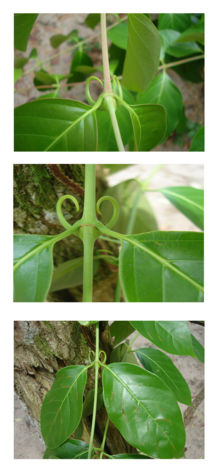bio.wikisort.org - Plant
Uncaria tomentosa is a woody vine found in the tropical jungles of South and Central America. It is known as cat's claw or uña de gato in Spanish because of its claw-shaped thorns.[1][2] The plant root bark is used in herbalism for a variety of ailments, and is sold as a dietary supplement.[2][3][4] There is no clinical evidence that cat's claw is effective for treating any human disease.[2][4]
| Uncaria tomentosa | |
|---|---|
 | |
| Scientific classification | |
| Kingdom: | Plantae |
| Clade: | Tracheophytes |
| Clade: | Angiosperms |
| Clade: | Eudicots |
| Clade: | Asterids |
| Order: | Gentianales |
| Family: | Rubiaceae |
| Genus: | Uncaria |
| Species: | U. tomentosa |
| Binomial name | |
| Uncaria tomentosa (Willd. ex Schult.) DC.[1] | |
Description
Uncaria tomentosa is a liana deriving its name from hook-like thorns that resemble the claws of a cat.[2] U. tomentosa can grow to a length of up to 30 m (100 ft), climbing by means of these thorns.[1] The leaves are elliptic with a smooth edge, and grow in opposing pairs. Cat's claw is indigenous to the Amazon rainforest, with its habitat being restricted primarily to the tropical areas of South and Central America.[1]
Taxonomy
There are two species of cat's claw commonly used in North America and Europe, Uncaria tomentosa and Uncaria guianensis, having different properties and uses.[2] The two are frequently confused but U. tomentosa is the more commonly used in traditional medicine.[5][6] U. tomentosa is further divided into two chemotypes that remain under preliminary research for their properties and compounds.[7] There are other plants which are known as cat's claw (or uña de gato) in Mexico and Latin America; however, they are entirely different plant species, belonging to neither the genus Uncaria, nor to the family Rubiaceae.[6]
Phytochemicals
Phytochemicals in Uncaria tomentosa root bark include oxindole and indole alkaloids, glycosides, organic acids, proanthocyanidins, sterols, and triterpenes, glycosides, tannins, polyphenols, catechins, rhynchophylline, and beta-sitosterol.[2][6][8]
Traditional medicine
Cat's claw bark has been used as a traditional medicine in South American countries over centuries for its supposed health benefits, and is a common herbal supplement.[2][4][6] As of 2021, there is no high-quality clinical evidence that it has any benefit in treating human diseases.[2][4]
Interactions
Cat's claw has extensive interactions with numerous prescription drugs.[2] Its safety over long-term use or during pregnancy has not been scientifically determined.[2][4]
Adverse effects
Individuals allergic to plants in the family Rubiaceae and different species of Uncaria may be more likely to have adverse reactions to cat's claw.[2] Allergic reactions can include itching, rash, and skin inflammation.[2] Gastrointestinal discomfort, nausea, headache, impaired kidney and hormonal effects, and neuropathy are other possible effects.[2][4]
People requiring anticoagulation, blood pressure, or immune therapy should not use cat's claw.[2][4]
See also
- List of ineffective cancer treatments
References
- "Uncaria tomentosa". Germplasm Resources Information Network (GRIN). Agricultural Research Service (ARS), United States Department of Agriculture (USDA). Retrieved 2008-03-01.
- "Cat's claw". Drugs.com. 6 September 2021. Retrieved 16 August 2022.
- "Assessment report on Uncaria tomentosa (Willd. ex Schult.) DC., cortex" (PDF). European Medicines Agency. 10 March 2015. Retrieved 11 January 2019.
- "Cat's claw". National Center for Complementary and Integrative Health, US National Institutes of Health. 1 May 2020. Retrieved 17 August 2022.
- Gattuso M, di Sapio O, Gattuso S, Pereyra LE (2004). "Morphoanatomical Studies of Uncaria tomentosa and Uncaria guianensis Bark and Leaves". Phytomedicine. 11 (2–3): 213–223. doi:10.1078/0944-7113-00315. PMID 15070175.
- "Detailed Scientific Review of Cat's Claw (archived)". M.D. Anderson Center. 31 May 2006. Archived from the original on 26 August 2013. Retrieved 10 January 2019.
- Keplinger K, Laus G, Wurm M, Dierich MP, Teppner H (1999). "Uncaria tomentosa (Willd.) DC. — Ethnomedicinal Use and New Pharmacological, Toxicological and Botanical Results" (PDF). Journal of Ethnopharmacology. 64 (1): 23–34. doi:10.1016/S0378-8741(98)00096-8. PMID 10075119.
- Cat's claw. LiverTox, US National Institute of Diabetes and Digestive and Kidney Diseases. 18 February 2019.
External links
 Media related to Uncaria tomentosa at Wikimedia Commons
Media related to Uncaria tomentosa at Wikimedia Commons- Uncaria tomentosa List of Chemicals (Dr. Duke's Databases)
На других языках
- [en] Uncaria tomentosa
[ru] Ункария опушённая
Ункария опушённая (лат. Uncaria tomentosa), (исп. uña de gato, англ. Cat's Claw — кошачий коготь) — древовидная лиана семейства Мареновые (Rubiaceae), произрастающая в тропических лесах Южной и Центральной Америки, по берегам и в предгорье Амазонки в Перу.Другой контент может иметь иную лицензию. Перед использованием материалов сайта WikiSort.org внимательно изучите правила лицензирования конкретных элементов наполнения сайта.
WikiSort.org - проект по пересортировке и дополнению контента Википедии